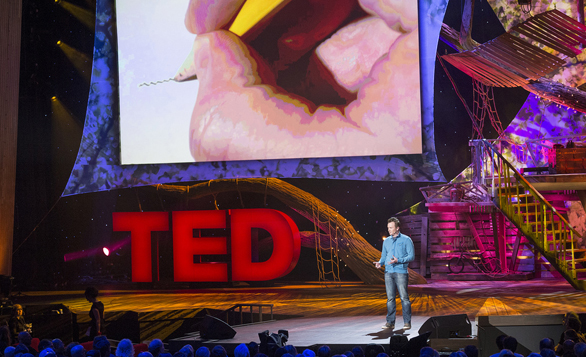 Phil Hansen has tattooed bananas, drawn a portrait on stacked Starbucks cups and created a Jimi Hendrix portrait out of matches, which he then burned. In other words, he isn’t the kind of artist who feels bound to paint on canvas.
Phil Hansen has tattooed bananas, drawn a portrait on stacked Starbucks cups and created a Jimi Hendrix portrait out of matches, which he then burned. In other words, he isn’t the kind of artist who feels bound to paint on canvas.
So how did Hansen happen upon such fascinating methods? By embracing a major limitation — a hand tremor that made it impossible for him to do the pointillist drawings he loved.
The theme of transcending constraints and roadblocks was a major theme at TED2013. While Hansen said in his talk, “Embracing the limitation can actually drive creativity … We need to first be limited in order to become limitless,” filmmaker Martin Villeneuve echoed the sentiment in his talk about making a sci-fi movie for $2 million. He said, “If you treat the problems as possibilities, life will start to dance with you in the most amazing ways.” And TED’s own Lisa Bu shared how she found her true calling when her dream of being an opera singer died. In a powerful moment of her talk, she said, “‘Coming true’ is not the only purpose of a dream. Its most important purpose is to get us in touch with where dreams come from, where passion comes from, where happiness comes from. Even a shattered dream can do that for you.”
Fascinated by this message, I asked Hansen a few questions at TED2013.
The power of limitations has been a real theme so far this conference. Why do you think this hasn’t traditionally been a part of the conversation about creativity?
I think due to the economy, we’ve been running into a spike of constraints while at the same time being more culturally fascinated with creativity than ever. One of the speakers, Danny Hillis, said “It’s hard to get people to focus on plan B when plan A is working so well.” Now we are in a place where lots of “plans As” are no longer working. Being forced to reevaluate is allowing us to see this connection between limitations and creativity that has always been right in front of us. Within this process, we are bringing curiosity back — curiosity about new possibilities that we hadn’t explored when plan A was working so well. And we are discovering better alternatives, as I’ve witnessed here from a lot of speakers so far at TED.
I’m curious — have you had any ideas for works since being at TED?
There’s really not an off button — I’m always running ideas in my head. A lot of ideas have surfaced in conversations with other attendees about possible collaborations that I’m really excited about.
I’ve been contemplating a text art project where I ask people to share their stories about limitations with me. I’ve had so many people come up to me and share their stories that I feel inspired to take this project on a bigger scale. I want everyone who looks at this piece to be able to find a story that they can relate to in looking at their own limitations.
So let’s say you’re a writer/artist/musician and you’re feeling a bit blocked. What are some things you can do to get the juice flowing again?
Creativity is simply connecting information, so we have to be in a relaxed mental state that is open to seeing these connections, but aware enough to capture them. Getting to this mental state is different for everyone, so I always suggest people experiment and find what works for them. Whenever I feel creatively stumped, my first instinct is to do something to get myself relaxed. I usually go on a long walk, like two hours long, because it takes at least 45 minutes for me to get out of my head and into the ether.
In order to be in the creative flow, it’s really important to be process driven and hold the results loosely. Sometimes it’s better to keep pushing through it. If you’re a writer, keep writing — even if it’s gibberish — and eventually it will flow again. Sometimes it’s better to destroy and start over. Or, if what you’re working on is too broad, impose a limitation to spark your creativity.
Comments (36)
Pingback: Phil Hansen Embraces Limitations to Drive Creativity (Video)
Pingback: Articles of Interest – March 8, 2013 « National Creativity Network
Pingback: Process Diary (2) – Further Research and Project Proposal | alvanblog
Pingback: How To Be More Creative - The Creative Mind
Pingback: How To Be More Creative | The Creative Mind
Pingback: Weekend Pixel Vol 03 - Pixelonomics
Pingback: Limitations make you more creative | Gabbie Finney
Pingback: Can limitations make you more creative? A Q&A with artist Phil Hansen | Law Essay Writing
Pingback: In praise of urban farmers: A Q&A with City 2.0 essayist Roman GausAquaponics | Aquaponics
Pingback: The Daily Scene | Acculturated
Pingback: Wizmo Blog » Blog Archive » Can limitations make you more creative? A Q&A with artist Phil Hansen